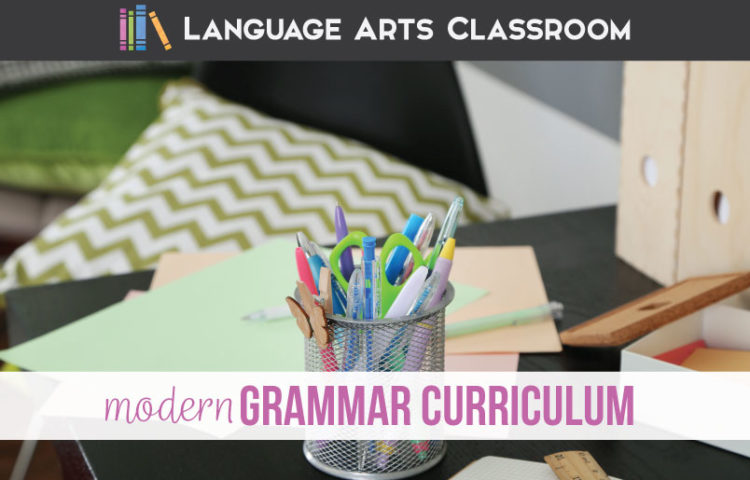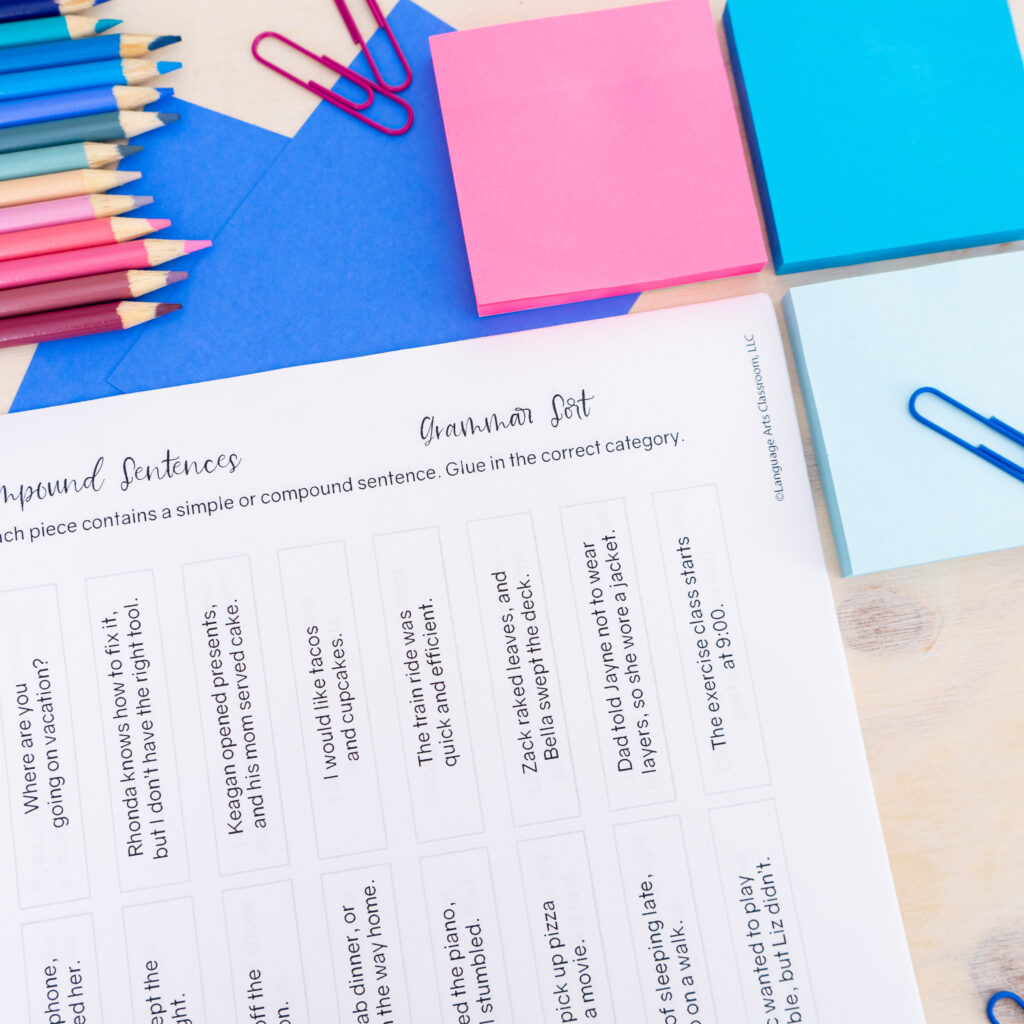“Discover the Best Middle School Grammar Curriculum” is part ten of a part-ten series about a practical approach to teaching grammar. You may want to begin with part one.
In 2018, Callisto Media hired me to write The English Grammar Workbook for Grades 6, 7, and 8, and my desire to help students understand grammar only grew. I expanded my grammar curriculum to reflect what I’d learned from working with a team of editors, linguistics, and writers.
What topics are covered in a typical middle school grammar curriculum?
A typical middle school grammar curriculum covers a range of topics, including parts of speech, sentence structure, punctuation, grammar rules, verb tenses, capitalization, sentence structure, and more. The curriculum aims to improve students’ understanding and usage of grammar in their writing and communication skills.
English grammar instruction looks like?
Too often, grammar instruction is “something to get out of the way.” A few worksheets, maybe some grammar practice and discussion of language skills, cover standards. Deep, meaningful conversations that connect grammar to vocabulary and writing skills never
But what could a meaningful middle school grammar curriculum mean for older students? Hopefully, it means their needs are met so they can analyze and apply language in their writing, speaking, and reading.
It also means standards are met—not simply checked off a list, but understood.
Finally, it means students approach life (college, training skills, workforce) after high school with a firm grasp of language. They should be able to express themselves in all areas of life.
That’s a tall order, and why a grammar curriculum is necessary. What should it look like?
In the previous nine posts of this grammar series, I’ve stressed that (like all aspects of teaching) teachers know their students. Teachers work with their classes and see what their students need. An English grammar curriculum shouldn’t only be a textbook with some practice sentences. It should contain engaging and hands-on grammar activities. Students should see connections from grammar to writing. Teachers should have easy venues to teach grammar in context. Mentor sentences. Interactive pieces.
Below, I’ve written about my middle school grammar curriculum inspired by my first book.
Since all students and communities are unique, I’ve allowed space for flexibility. Let me know what you think.
Middle School Grammar Curriculum: requirements
An English grammar curriculum for middle school students should be differentiated, age-appropriate, interactive, and visually appealing. It must have the freedom for teachers to review when necessary and advance work when learners are ready. It must connect sensibly to a writing program and be grade level appropriate.
Any language arts program should prepare leaners for the next level of learning while also considering they might need a spiral review from previous years.
Finally, a middle school grammar curriculum must move past basic recitation and toward enrichment. Those requirements might look like. . .
Be differentiated.
A differentiated grammar curriculum for middle school stands out the most to me. For instance, at different times, teachers must review the eight parts of speech and parts of a sentence with all groups.
Why? Well, students don’t always remember those concepts, and students need that foundation to work with more complex aspects. BUT, and this is huge, not all students need the same review, and modern students dislike English grammar recitation methods.
So in a class, you could have some students stuck on modifiers while others struggle to recognize linking verbs. Other writers might need a review of verb moods and once you start, realize they additionally need a review of verbs.
Like all components of a language arts class, different students need to study different areas. This means a grammar curriculum needs different levels of material, and a lot of practice tools.
When reviewing grammar, I typically have different groups working simultaneously. It all is differentiated. Plus? Some students appreciate the straightforwardness grammar worksheets bring. Others want to slide through a presentation multiple times, while others prefer taking notes on a flip book. They learn differently, and the perfect grammar curriculum will take that into account.
Be age-appropriate.
What message does it send to tweens and teens when we use elementary tools with them? It sets the wrong tone: they’re already behind, they should already know this, and this is ‘baby stuff.’ Images and layout matter.
Yes, the standards call for nouns to be covered in early elementary school. Well, older students might need a review. The grammar book or other materials should not look the same as it did in first grade, though.
Furthermore, teachers encourage students to question everything, and older students have no problems doing so! My tip? Be ready to answer students. If classes wonder why they are studying pronouns again, explain that they need to have clear antecedents and that pronoun usage will be important when they write large (and confusing!) papers with gobs of research. For instance, every section in my grammar textbook has specific answers for when students ask, “why am I learning this?
The grammar curriculum should be age-appropriate! Explaining the complex strands of the English language can be part of our teaching.
Connect to vocabulary and all of ELA.
For learners to deeply meet the language standards, you must connect grammar to vocabulary. The standards are written in such a way that a bridge from parts of speech is natural when covering word choice (connotation and denotation). As a next step, connect the vocabulary use back to the punctuation and sentence structure used with the vocabulary terms.
Additionally, language standards also emphasize the importance of integrating grammar instruction with other aspects of English Language Arts (ELA). This means that while teaching grammar, we should also focus on reading, writing, listening, and speaking skills. By highlighting the connection between grammar and other language elements, we can help students see the relevance and applicability of their grammar knowledge in real-life situations.
Be hands-on/interactive.
Interactive grammar includes interactive notebooks, but goes beyond that. Students can manipulate sentences, and they can do this in hands-on fashion. Students should build sentences (literally, word by word with manipulatives) and play with the information. Once students physically hold their language, teachers can easily transfer that material to writing sentences.
Grammar sorts are another tool to help middle school classes engage in rich discussions about language.
Finally, grammar coloring sheets work too.
Use worksheets?
Grammar worksheets can provide clarity for students. A straight-forward, no fuss approach works with many classes. For students who are homebound, tutors often appreciate the answer keys so that they can cover information confidently. Finally, when spelling is a concern (like with confusing words), a two-minute review with a worksheet can be effective.
Other times, classes crave engagement, past a worksheet.
After I finished my book, I knew part of my calling as a language arts teacher was to create fun grammar activities.
Relate to life.
English teachers excel at relating literature and writing to life. Heck, we can even tie poetry to real life! Honestly, do teachers habitually tie grammar to real life? I still remind myself to address language. Doing so may seem awkward at first, but it can be done. Advertisements (print, video, Internet), marketing tools (drink containers, cracker boxes), speeches, nonfiction, and (of course) literature all use language with purpose.
An open discussion with students can be simple; ask them to explain why a certain action verb was used or why a short sentence was used. Relating grammar to life can involve the debate between written and spoken grammar. Classes may think that language used in a different way would be more effective. Wonderful! Discussions will help students see that language is part of their lives.
What would a dream grammar curriculum mean for you to use with middle school students? These traits are what I’m stressing in my comprehensive grammar curriculum. (You can see the preview for downloadable images and details.)
If grammar is an afterthought, a part of the curriculum thrown together, students will treat it as such. A grammar curriculum should be diverse and include a variety of tools to meet students where they are in their understanding of language.











